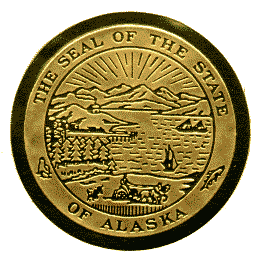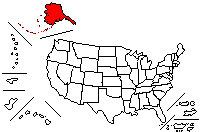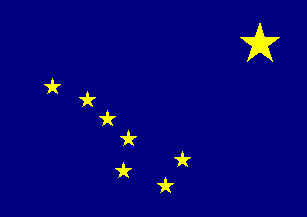
Free Web Hosting - Watch Free Movies Online - Watch Free TV Online - Free Web Pages
Find the cheapest Local Gas Prices and Gas Stations in your neighborhood and surrounding area.
 |
Free Web Hosting - Watch Free Movies Online - Watch Free TV Online - Free Web Pages Find the cheapest Local Gas Prices and Gas Stations in your neighborhood and surrounding area. |
















Alaska's Flag |
Bandera de Alaska
Ocho estrellas de oro |


Bandera:
Alaska adoptó la bandera estatal oficialmente en el 1959.
El campo azul representa el cielo, el mar y los lagos de las montañas.
También representa las flores salvajes de Alaska. En la bandera se encuentra
ochos estrellas doradas: siete son la contelación de la Osa Mayor, o
del Gran Mirlo. La octava es la Estrella Polar, Polaris, representando que
es el estado que queda más al norte.
La bandera de Alaska fué diseñada por John Bell (Benny) Benson,
un chico de trece años de edad en un orfanato en respuesta a un concurso auspiciado por el
Departamento de la Legión Americana de Alaska. El premio fué ganado en el 1927. La bandera
fué adoptado por la legislatura terrirorial en mayo de 1927 como la bandera oficial de Alaska.
Cuando Alaska entró a formar parte de la unión en el 1959, la bandera territorial se convirtió
en la bandera del estado. Todos los diseños para el concurso, tanto como el un premio de
Benny, un reloj de oro con la bandera, esta in el Museo Estatal de Alaska en Juneau. Benny también
ganó $1000 para viajar a Washington D.C. para presentar la bandera al Presidente Coolidge, pero
nunca fué porque su padre enfermó y el Presidente Coolidge estaba fuera del país.
Entonces los $1000 fué puesto en un fondo para su educación.

Alaska
Capital City: Juneau (se pronuncia Yun-nau)
National: Alaskans
Admission to Statehood: January 3, 1959
Motto: North To The Future
In 1963, the Alaska Centennial Commission announced a competition
to determine a distinctive centennial motto and emblem for Alaska.
During the competition, which carried a $400 prize, 761 entries were
received. In December 1963, the commission announced that “North to the
Future,” the entry submitted by Juneau newsman Richard Peter, had won.
The legislature adopted this motto officially in 1967.
Nickname: The Last Frontier
Origin of state's name: Based on an Aleut word "alaxsxaq"
literally meaning
"object toward which the action of the sea
is directed" or more simply "the mainland".
Alaska (se pronuncia á-las-ka en inglés) (se pronuncia A-lás-ka en español)
Ciudad Capital: Juneau (se pronuncia Yún-nau en inglés y español)
Gentilicio: Alaskeños
Admisión como Estado: 3 de enero de 1959
Lema: El Norte para el Futuro
En 1963, la Comisión Centenaria de Alaska aunció una competencia para elegir un lema y
emblema distintivo centenario para Alaska. Durante la competencia, el cuál llevaba un premio
de $400, recibió 761 participantes. En diciembre de 1963, la comisión anunció que "El Norte
para el Futuro" sometido por un periodista de Jeneau Richard Peter, había ganado.
La Legislatura adoptó este lema oficialmente en el 1967.
Cognomenteo: La Ultima Frontera
Origen del nombre: Basada en una palabra Aleutiana "alaxsxaq" que literalmente
significa "Objeto através del cual el mar se dirige" o más simple "La Tierra Principal".


STATE SEAL
The state seal was originally designed in 1910 while Alaska was a territory and not a state.
The rays above the mountains represent the Northern Lights. The smelter symbolizes mining.
The train stands for Alaska’s railroads, and ships denote transportation by sea.
The trees symbolize Alaska’s wealth of forests, and the farmer, his horse, and the three
shocks of wheat represent Alaskan agriculture.
The fish and the seals signify the importance of fishing and wildlife to Alaska’s economy.
Sello Estatal
El sello estatal fué originalmente diseñado en 1910 mientras Alaska era un territorio y no un estado.
Los rayos arriba de la montañas representan las luses del norte. La fundición representan las minas.
El tren representa los ferrocarriles de Alaska, y la embarcación denota la transportación por mar.
Los arboles simbolizan los saludables bosques de Alaska, y la finca, sus caballo, y tres grañas trigo
representa la agrigulcuta Alaskeña.

History
Alaska, the largest in area but among the least populated U.S.
states, lies astride the Arctic Circle, apart from the "Lower 48"
conterminous states. It is bordered on the north by the Arctic
Ocean, on the east by the Yukon Territory,
on the southeast by British Columbia, on the south by the
Gulf of Alaska and the Pacific Ocean, and on the west by
the Bering Sea, the Bering Strait, and the Chukchi Sea. Little
Diomede Island, in the Bering Strait, is only 4 km (2.5 mi)
from Russia's Big Diomede Island.
Initially inhabited by Inuit, Aleut, Athabascans, Tlingit,
and Haida, Alaska was first visited by Europeans in the early 18th
century. In 1867 the United States purchased Alaska from Russia
for only $7.2 million. Alaska's modern economic development was
accelerated by World War II, when U.S. military bases were established
there. Alaska became a state in 1959.
The name Alaska comes from an Aleut word thought to mean "mainland"
or "land that is not an island"; the name originally was restricted
to the Alaska Peninsula but by 1800 was used to denote all of
present-day Alaska.
The Aleutian Islands are a chain of islands stretching west
1,800 km (1,100 mi) from the tip of the Alaska Peninsula and
separating the Bering Sea on the north from the Pacific Ocean
on the south. Part of the state of Alaska, they include about
70 islands and scores of islets and have an area of 17,666 sq./km.
(6,821 sq./mi. ). The population is 10,067 (1990). Five major
island groups stretch from east to west: the Fox, Islands of the
Four Mountains, Andreanof, Rat, and Near. Virtually no trees grow on the islands, and
vegetation includes grasses, sedges, and low flowering plants.
Cold air and currents of the Bering Sea meet the warmer influences
of the Pacific and cause a year-round mixture of fog, rain,
high winds, and relatively uniform temperatures (annual average
about 3 degrees C/38 degrees F). Discovered in 1741 by Vitus
Jonassen Bering and Aleksei Chirikov, the islands were claimed
by Russia. The Russians exploited the fur resources
(blue foxes, seals) and nearly eliminated the native Aleut population.
The islands were purchased along with Alaska from Russia
by the United States in 1867. Unalaska (1760-70) is the oldest
settlement.b>
Historia
Alaska, la más grande de área de los Estados Unidos,
pero el de menos población. El estado se encuentra en el Circulo Polar
Ártico, apartados de los otros 48 estados continentales. Es
rodeado en el norte por el océano ártico, en el este por el
territorio de Yukon, en el sureste por British Colombia, en el sur por
el golfo de Alaska y del Océano Pacífico, y en el oeste el mar de Bering,
el estrecho de Bering, y el mar de Chukchi que es una pequeña isla de Diomede, en
el estrecho de Bering, está a solamente 4 kilómetros (2.5 mis) de la
isla grande de la isla grande de Diomede de Rusia. Habitado inicialmente por Inuit,
Aleutianos, Athabascansnos, Tlingit, y Haida. Alaska fué primero visitada por
europeos al principio décimo octavo siglo . En 1867 los Estados
Unidos compraron a Alaska a Rusia por solamente $7.2 millones. El
desarrollo económico moderno de Alaska fué acelerado por la guerra
mundial II, cuando los E.E.U.U.. las bases militares fueron
establecidas allí. Alaska se convirtió en Estado en 1959. El
nombre Alaska viene de la palabra de Aleutiana
que significa tierra principal o Tierra que no es isla; el
nombre fue restringido originalmente a la península de Alaska pero
antes de 1800 fue utilizado denota toda la Alaska actual.
Las islas Aleuletianas son una cadena de las islas que se
alargan al oeste 1,800 kilómetros (1,100 mis) de la extremidad de la
península de Alaska y que separan al Bering están en el norte del
Océano Pacífico en el sur. Parte del estado de Alaska, incluyen
cerca de 70 islas y cuentas de islotes y tienen un área de sq./km
17,666. (6,821 sq./mi.). La población es 10,067 (1990). Hay cinco grupos principales de
isla a lo lardo del este al oeste: el Fox,
islas de las Cuatro Montañas, Andreanof, Rata, y Acerca. No los árboles
virtualmente en las islas, y la vegetación incluye hierbas,
juncias, y las plantas florecientes bajas. El frío al aire y a las
corrientes del Bering es reunión a influencias más calientes del
Pacífico y causa mezclas a lo largo de todo el año de la niebla, hay
la lluvia, de los fuertes vientos, y de las temperaturas relativamente
uniformes (promedio anual cerca de los grados de 3 grados C/38 F).
Descubierto en 1741 por Vitus Jonassen Bering y Aleksei Chirikov, las
islas fueron demandadas por Rusia. Los rusos explotaron los recursos
de la piel (zorros, sellos azules) y eliminaron casi a la población
nativa de Aleut. Las islas fueron compradas junto con Alaska a Rusia
por los Estados Unidos en 1867. Unalaska (1760-70) es el más viejo
establecimiento..
